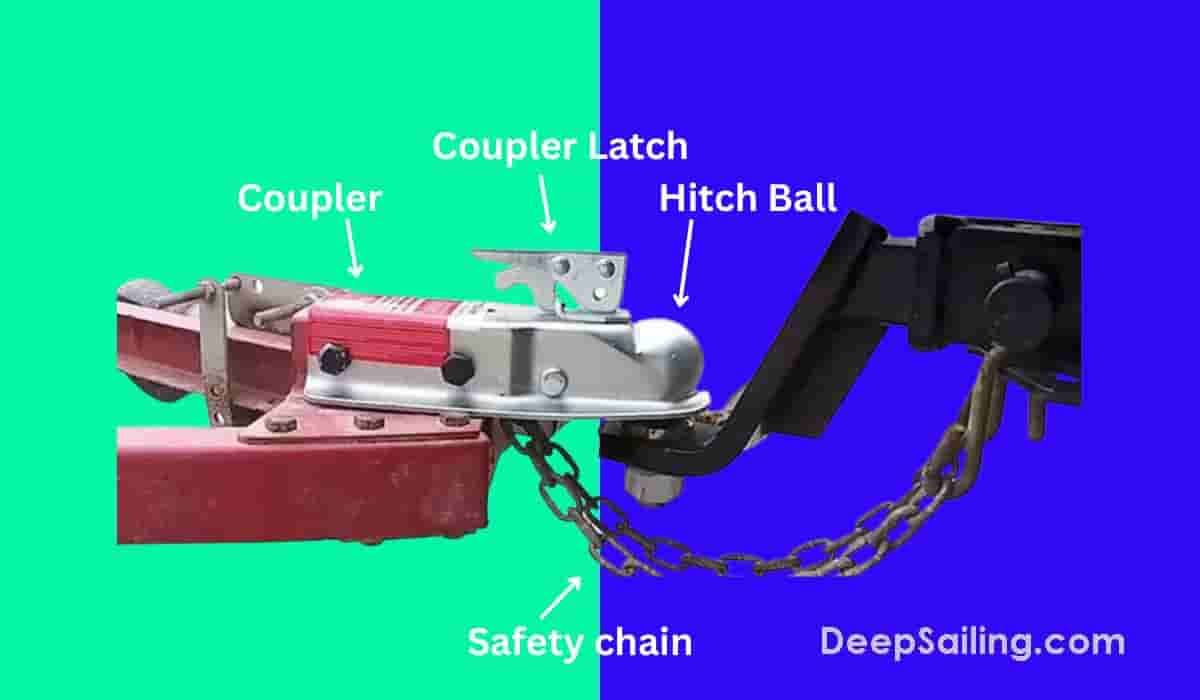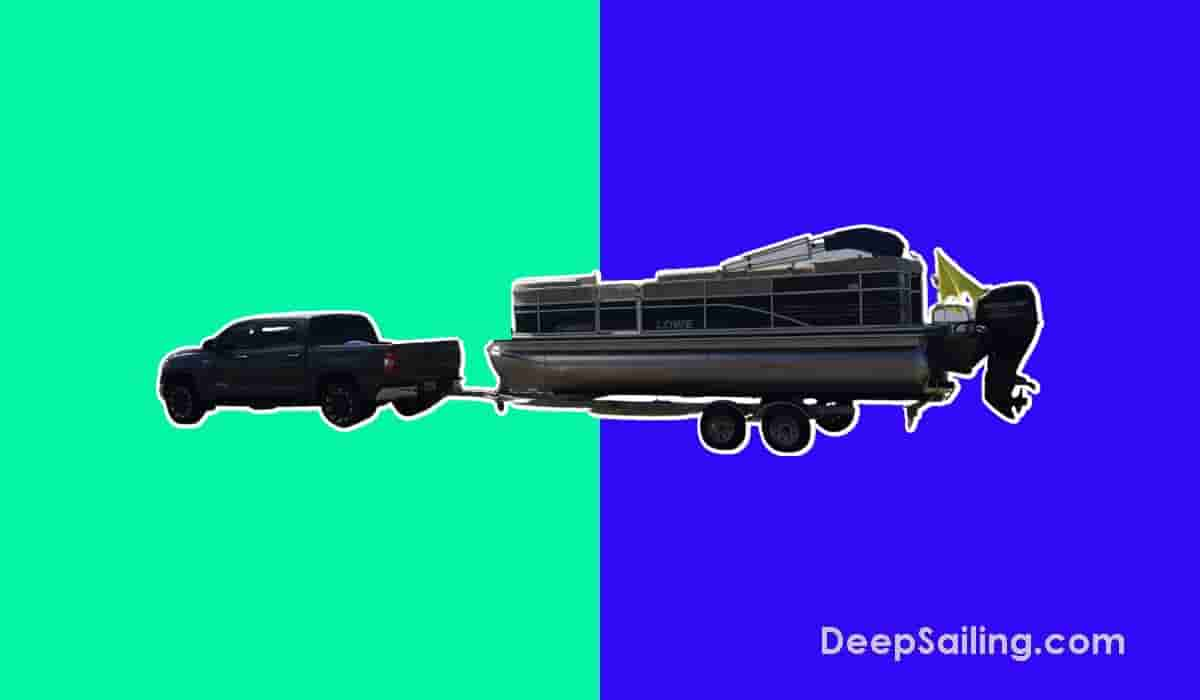Towing a pontoon boat safely is important for the safety of other road users and for the protection of the boat itself.
Understanding the pontoon boat towing weight capacity will ensure your towing vehicle will not get damaged when trailering the pontoon to and from the water.
Towing a pontoon safely is done in 5 steps.
To tow a pontoon:
- Attach the pontoon trailer to the towing vehicle
- Prep the trailer for trailering
- Tow the pontoon to the boat ramp
- Prepare for moving the pontoon into the water
- Release the pontoon into the water
If you are a beginner towing a pontoon, it is recommended to have at least one additional adult as this will help with visibility when trailering.
>1. Attach The Pontoon Trailer To The Towing Vehicle

The first step of towing a pontoon boat is to securely attach the pontoon towing trailer to the towing vehicle.
To attach a pontoon towing trailer to a vehicle:
- Check the vehicle's towing capacity: Check your specific vehicle's towing capacity in the manufacturer owner's manual to ensure your vehicle will be able to tow the pontoon weight. A standard pontoon will weigh between 2,000 and 2,500 pounds and a standard pontoon towing trailer will weigh 1,500 pounds so a vehicle will need to be able to tow a weight of between 3,500 and 4,000 pounds at a minimum in most instances
- Ensure the correct sized hitch and ball are installed: Ensure the hitch and ball installed on the towing vehicle are the right sizes to fit the towing trailer properly and securely. The boat trailer dealer will be able to advise on the right size ball and hitch to fit your specific towing trailer. Trailer hitch balls come in four different sizes which include 1-7/8, 2, 2-5/16, and 3 inches
- Ensure the lock pin is in place on a hitch with a removable drawbar (where applicable): If the hitch comes with a removable drawbar, ensure the lock pin is in place to keep the hitch firm and secure. The drawbar is located at the base of the hitch
- Ensure the nut on the bottom of the hitch ball is tight: Assess if the hitch ball nut is tight. Use a spanner to tighten it if it is loose. The hitch ball nut is located below the ball on the hitch
- Reverse the towing vehicle back to the trailer: Reverse the towing vehicle back to the trailer until the hitch ball on the vehicle is directly under the trailer's coupler. It is helpful to have a second person for better visibility during this process
- Lower the coupler with the jack: Use the jack on the trailer to lower the coupler until the coupler is connected to the ball and all the weight is on the hitch. Lowering the jack is done by twisting the handle in an anti-clockwise direction
- Securely lock the coupler: Use the coupler latch on top of the coupler to lock it in place. Then insert the locking pin to ensure the trailer is attached correctly to the hitch
- Connect the lights and safety cables: Connect the lights and safety cables from the trailer to the towing vehicle
- Raise the jack into its trailering position: Raise the jack until the dolly wheel is pointing in the aft direction. Lock it into place in this position
- Tie down the front and rear tie-down cables: Tie down the front and rear tie-down cables and ensure they are tight and secure. They will help secure the vessel as it's trailering on the road
Attaching the towing trailer securely to the vehicle will take approximately 15 minutes to complete.
2. Prep The Trailer For Trailering
The second step is to prep the trailer for trailering.
To prep the trailer for towing:
- Check the trailer lights and turn signals to ensure they are working properly
- Ensure there is 10 inches or more ground clearance between the pontoon's outboard motor and the ground. Use an adjustable transom saver if you need more ground clearance when towing
- Ensure the boat trailer tire pressures are between 50 & 65 psi. (this can vary depending on the trailer)
- Ensure the trailer tires are compatible with trailering. Ensure there is an "ST" logo on the sidewall of the tire or the words "Trailer Use Only" which indicates that the tires are made specifically for trailering
- Ensure the boat trailer tires are roadworthy. A boat trailer's tire tread depth should be 4/32 of an inch deep according to the US. Department Of Transport
- Check the front and rear tie-down cables to ensure they are securing the pontoon on the trailer
- Make sure there are no loose items inside the pontoon
Prepping the towing trailer for trailering safely takes 10 minutes to complete.
3. Tow The Pontoon To The Boat Ramp

The third step is to tow the pontoon on the road to the boat ramp.
To tow the pontoon to the boat ramp:
- Allow extra width when making turns: People towing pontoons should allow extra width when trailering. Make extra wide turns to avoid clipping or mounting kerbs
- Follow boat trailering speed limits: Boat trailering speed limits will typically range from a maximum speed limit of 55 m.p.h. to 65 m.p.h. depending on the state in America. A boat owner should know the speed limit for towing a trailer in their specific state before towing the pontoon. Check the U.S. Department Of Transport for state-specific trailering speed limits
- Stay in the slower lanes on the highway: If towing a pontoon on the highway, stay in the slower lanes to avoid holding up traffic
- Ensure there is sufficient fuel for the journey: Ensure the towing vehicle has enough fuel to reach the boat ramp destination if it's your first time towing a pontoon
- Park near the boat ramp on arrival: Park near the boat ramp but not on it as you arrive at the destination. Do not block the boat ramp as it will take 10 minutes to prep the pontoon for moving it into the water
4. Prepare For Moving The Pontoon Into The Water

The fourth step is to prepare for moving the pontoon into the water.
To prepare for moving the pontoon into the water from the towing trailer:
- Park near the boat ramp on a horizontal surface
- Disconnect the trailer lights cable from the towing vehicle
- Release the tie-down cable on the front of the trailer
- Release the aft tie-down cable on the rear of the trailer
- Do not release the winch strap yet as it could cause the pontoon to fall off the trailer as you reverse down the boat ramp
- Remove the transom saver
- Attach a bow line with a minimum length of 15 feet
Prepping the pontoon for moving it into the water from the trailer takes approximately 10 minutes to complete.
5. Release The Pontoon Into The Water
The fifth step is to release the pontoon into the water from the trailer.
To release the pontoon into the water from the towing trailer:
- Reverse the pontoon down the boat ramp in a straight line
- Keep reversing until the fenders of the boat trailer are just underwater
- Place the towing vehicle in park and set the park brake
- Get out of the towing vehicle and check the rear of the trailer to see if there is sufficient water depth without the outboard motor propellers hitting off the ground
- Move back to the bow and now release the winch
- Mount the pontoon on the trailer and grab the 15ft+ bow line as you enter the pontoon
- Start the outboard motor in low revs, typically between 600 to 900 rpm
- Lower the outboard motor into the water
- Place the throttle backwards or downwards to reverse the pontoon off the trailer into the water slowly
- Use the bow line to tie the pontoon to a nearby dock area
- Return to the towing vehicle and remove it from the boat ramp to a safe parking spot
Releasing the pontoon from the boat trailer into the water takes approximately 10 minutes to complete.
Pontoon Boat Towing Checklist
Below is a pontoon towing checklist to follow.
Frequently Asked Questions About Towing A Pontoon
Below are the most commonly asked questions about towing a pontoon boat.
How Do You Remove A Pontoon From The Water For Towing?
To remove a pontoon from the water for towing it:
- Reverse the towing trailer down the boat ramp until the fenders are just underwater
- Set the parking brake on the towing vehicle
- Enter the pontoon in the water and start it up
- Slowly approach the towing trailer
- Mount the pontoon onto the trailer slowly
- Make sure the bow of the pontoon is centered with the bunks on the trailer
- Tilt the outboard motor up slowly as you approach the ramp and the front of the trailer. This will stop your motor from being damaged
- Slowly increase power until the boat meets the stop on the trailer winch
- Once the pontoon is on the trailer, make sure the ratchet lock on the winch is set and attach the bow tie down
- Turn off the engine and get out of the pontoon
- Attach the winch strap to the pontoon. This is located at the front of the towing trailer
- Connect the front and rear tie downs
- Ensure the outboard motor has been lifted to allow for sufficient ground clearance as you pull off the boat ramp
- Enter the towing vehicle and release the parking brake
- Slowly pull the trailer off the boat ramp and into a horizontal position to get it prepped for trailering
What Items Do You Need To Tow A Pontoon?
The items needed to tow a pontoon boat are:
- Towing vehicle with a hitch
- Fuel for the towing vehicle
- Towing trailer
- Minimum 15ft length dock line
- Adjustable transom saver
How Long Does It Take To Prepare A Pontoon For Towing?
It will take approximately 25 minutes to prepare a pontoon boat for towing. This timeframe includes attaching the trailer with the pontoon to the towing vehicle and checking everything is prepped for the towing journey.
How Long Does It Take To Remove A Pontoon Into The Water After Towing?
It will take approximately 20 minutes to remove a pontoon from the trailer into the water after towing. This timeframe includes preparing the pontoon for removal from the towing trailer and releasing the pontoon into the water.
How Many People Are Required For Towing A Pontoon?
One person is required for towing a pontoon. However, it is recommended to have 2 people when towing a pontoon as the second person can help with visibility when backing the trailer down the boat ramp.
What Are The Benefits Of Towing A Pontoon Boat?
The benefits of towing a pontoon boat are:
- Flexibility: Towing a pontoon boat allows you to take your boat to different locations and enjoy different bodies of water from rivers, lakes, and coastal seas. This can add variety to your boating experiences and allow you to explore new areas
- Convenience: Towing a pontoon boat means you don't have to worry about storing it at a marina or paying for dockage fees. You also don't have to worry about the boat being damaged in rough waters or storms
- Cost-effective: Towing a pontoon boat can be a cost-effective option especially if you already own a suitable vehicle for towing. It can save you the expense of renting a slip at a marina or purchasing a boat lift. Marina slip savings of $15 per foot of pontoon length which means potential savings of $300 for the average-sized pontoon
What Are The Risks Of Towing A Pontoon Boat?
The risks of towing a pontoon boat are:
- Damage to the pontoon: A poorly secured pontoon on a trailer can result in pontoon damage when it is towed on the road
- Damage to the towing vehicle: If the towing vehicle is overloaded by the weight of the pontoon and trailer, it can cause substantial damage to the vehicle which could be expensive to fix
- Injuring other road users: Trailering with a pontoon means you will need to allow extra space on the road. If you are inexperienced in towing a pontoon, you may have a road accident and injure other motorists
What Should You Avoid When Towing A Pontoon Boat?
When towing a pontoon boat, you should avoid:
- Not safely securing the pontoon on the towing trailer
- Not connecting the safety cables to the towing vehicle
- Driving with low air pressure in the trailer tires
- Not connecting the electrical sockets to the vehicle
- Not locking the trailer jack securely
- Towing with loose items in the pontoon
- Overloading the towing vehicle with too much weight
- Towing with the outboard motor too low to the ground
- Using a towing vehicle that is not designed to tow the weight of the pontoon and the trailer
What Vehicles Can Tow A Pontoon Boat?
Cars, SUVs, tractors, minivans, trucks, RVs, and jeeps with a towing capacity that is higher than the total weight of the pontoon and the towing trailer can tow a pontoon boat. For example, if the total weight of your pontoon and towing trailer is 4,000 lbs., your vehicle must have a towing capacity of greater than 4,000 lbs. to tow this pontoon.
Do You Need Insurance To Tow A Pontoon?
Most people towing a pontoon are covered by their car insurance policy. However, it is very important that the person towing the boat checks with their specific insurance provider to confirm they are insured. Do not tow a boat on a road without confirming that towing is covered in the insurance policy beforehand.
Can A Car Tow A Pontoon Boat?
Yes, a car can tow a pontoon boat provided the car has a towing capacity that is higher than the total weight of the pontoon and the towing trailer. Check your car's owner manual for specific towing capacity information for your vehicle.
If the pontoon and trailer weight combined is higher than the towing capacity of the car, then the car cannot tow the pontoon.
What Is The Maximum Size Pontoon That Can Be Towed?
For most states in America, the maximum sized pontoon that can be towed ranges from 60ft to 85ft in length depending on the state. For state-specific information on what the maximum allowable size is in that state, check out the U.S. state boat towing laws. A boat owner should be aware of their local state laws on the maximum size allowed for towing before towing the pontoon.
What Is The Minimum Size Pontoon That Can Be Towed?
There is no minimum pontoon size requirement for towing a pontoon.